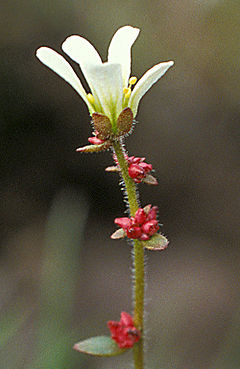During a lunchtime wander round the alpine garden in Durham University Botanical Gardens this week I read a signboard I hadn’t noticed before which mentioned that the name Saxifrage comes from two Latin words; ‘Saxum’ means rock and ‘frag-’ is from ‘frangere’, which means to break. This makes sense – after all, theses plants often grow on mountains, amongst rocks. An obvious example would be the delicate Saxifraga siberica which we found growing amongst the rocks dampened by meltwater from Thajiwas glacier in Kashmir at about 3000 m (see Glacier hunting at Sonamarg and Thajiwas glacier).

Saxifraga siberica, Thajiwas glacier, Sonamarg
Most members of the Saxifrage family come from cold subarctic or alpine environments, often at altitude, but not all have such inhospitable homes. The tiny Opposite-leaved Golden-saxifrage (Chrysosplenium oppositifolium) which I found growing with mosses and fungi on the damp woodland floor of near the river Wear today is a case in point.

Opposite-leaved Golden-saxifrage (not yet in flower), Turkeytail fungus and Mnium moss forming a woodland community
Despite the pretty flowers, many mountain saxifrages reproduce vegetatively more than by seeds, producing miniature pearl-like bulbs or bulbils where the lower leaves meet the stem. These drop to the ground after the plant has flowered and grow to produce a new basal rosette of leaves which will flower the following year. Perhaps insect pollinators are limited at the altitudes where many of these species grow, or maybe the bulbils are just more robust and their early growth gives the plants a head start in a relatively short growing season after the snow melts.
It turns out that the stones from which saxifrages get their name may be kidney stones rather than rocks. Meadow saxifrage, Saxifraga granulata, grows widely in central and eastern parts of the UK and, according to John Gerard’s Herbal of 1597, S. granulata bulbils these were boiled in wine and sold under the name Semen Saxifragae Albae (literally, white rock-breaking seeds) for the treatment of kidney stones, and multifarious other ailments.

Saxifraga granulate. Image: H. Zell via Wikimedia commons

Saxifraga cernua with bulbils. Image: Mike Segeln via Wikimedia commons
Of course we may be most likely to see saxifrages is in our own gardens – many species and cultivars are grown as ornamentals, providing groundcover or as cushion plants in rock or alpine gardens. London pride (a cross between Pyrenean saxifrage and St. Patrick’s cabbage) is not a personal favourite, but I do love the delicate pink and white flowers of mossy saxifrages.

Saxifraga x arendsii ‘Purple Robe’. Photo courtesy of NetPS Plant Finder
Stroh, P.A. (2015) Saxifraga granulata L.. Meadow Saxifrage. Species Account. Botanical Society of Britain and Ireland.
Well, I learn something new every day! Love the etymology of plant names (any names come to that).
London Pride was about the only thing I could grow under the Lawsoniis in Dad’s garden.
We had a lot in my childhood garden too and I never really liked it, for some reason!
Really interesting, especially about the vegetative propagation by bulbils
Yup – I didn’t know that before.
[…] alpine rock garden is really coming into its own now. Taking a closer look at one of the Saxifrage species provides a surprise – what look like quite plain cream flowers are covered in deep red spots – […]